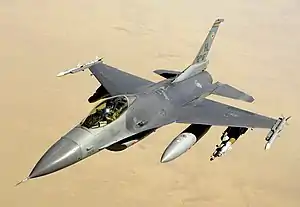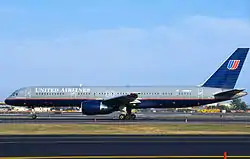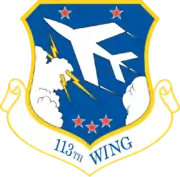Marc H. Sasseville
Marc Henrys Sasseville (born March 23, 1963) is a United States Air Force lieutenant general who currently serves as the 12th Vice Chief of the National Guard Bureau. He previously served as the commander of the Continental United States North American Aerospace Defense Command Region and concurrently as commander of the First Air Force (Air Forces Northern) from June 2019 to August 2020. Sasseville previously served as commander of the 113th Wing, District of Columbia Air National Guard at Andrews Air Force Base in Maryland and was the first Hispanic American to hold the position. On September 11, 2001, Sasseville was the acting operations group commander under the 113th Wing of the D.C. Air National Guard. He was one of four pilots given the mission of finding United Flight 93 and destroying it, even if it meant ramming the plane. The tactic would be similar to the suicide military tactics known as Sonderkommando Elbe missions used by the military aviators from Nazi Germany in World War II.[1] He also served as the Senior Defense Official/Defense Attache, Turkey, United States European Command, Ankara, Turkey.[2] He assumed his current assignment in August 2020.
Marc H. Sasseville | |
|---|---|
.jpg.webp) Lieutenant General Marc H. Sasseville | |
| Birth name | Marc Henrys Sasseville Frontera |
| Born | March 23, 1963 Wright Patterson Air Force Base, Ohio |
| Allegiance | United States |
| Service/ | United States Air Force |
| Years of service | 1985–present |
| Rank | Lieutenant General |
| Commands held | Vice Chief of the National Guard Bureau First Air Force 113th Wing 113th Operations Group 121st Fighter Squadron |
| Battles/wars | Iraq War |
| Awards | Air Force Distinguished Service Medal Defense Superior Service Medal (2) Legion of Merit (2) Bronze Star Medal |
Early years
Sasseville (birth name: Marc Henrys Sasseville Frontera[note 1]) was the oldest of three children born to Yita Frontera Lluch, a native of Yauco, Puerto Rico and Air Force Officer Albert "Al" Sasseville at Wright Patterson Air Force Base, in Ohio.[3] After graduation from high school he was accepted to the United States Air Force Academy in Colorado. On May 29, 1985, he earned his Bachelor of Science degree in International Affairs and a second lieutenant's commission in the Air Force from the academy.[4]
Military career
Sasseville was assigned to the Undergraduate Pilot Training program at Columbus Air Force Base, Mississippi, from 1985 to 1986, where he earned his pilot wings. From 1986 to 1987 he was assigned to the F-16 Replacement Training Unit at MacDill Air Force Base in Florida. He was promoted to first lieutenant on May 29, 1987.[4]
Sasseville served in various operational units during his active duty. From 1987 to 1989, Sasseville served in his first overseas assignment as programmer of the 613th Fighter Squadron, 401st Tactical Fighter Wing, at Torrejon Air Base, Spain. He was promoted to captain on May 29, 1989. He then returned to the United States and was assigned as chief of squadron weapons for the 309th Fighter Squadron, 31st Tactical Fighter Wing at Homestead Air Force Base, Florida. In 1992, he went overseas again as flight commander of the 13th Fighter Squadron, and chief of standardizations and evaluations of the 35th Operations Group at Misawa Air Base in Japan.[4]
In 1995, Sasseville was reassigned to Nevada where he served as wing weapons chief of the 57th Operational Support Squadron, 57th at Nellis Air Force Base. He earned a master of arts degree in aeronautical science technology from Embry Riddle Aeronautical at the University of Florida in 1996. He served as wing weapons chief until 1997. On January 1 of that same year, he was promoted to major and sent overseas to Kunsan Air Base in the Republic of Korea where he served as assistant director of operations, 80th Fighter Squadron of the 8th Fighter Wing. From 1998 to 1999, Sasseville was the program manager and F-22 core pilot of the 422nd Test and Evaluation Squadron at Nellis AFB in Nevada.[4]
September 11 attacks

In 2000, Sasseville joined the District of Columbia Air National Guard as a traditional guardsman. He was promoted to lieutenant colonel on January 18, 2001, and named director of operations, 121st Fighter Squadron, 113th Wing, District of Columbia Air National Guard at Andrews Air Force Base in Maryland.
On September 11, 2001, United Airlines Flight 93 was hijacked by four members of al-Qaeda as part of the September 11 attacks. The hijackers breached the aircraft's cockpit and overpowered the flight crew approximately 46 minutes after takeoff. Ziad Jarrah, a trained pilot, then took control of the aircraft and diverted it back toward the east coast of the United States in the direction of Washington, D.C. The hijackers' specific target was the United States Capitol.[5]
That morning Major Daniel Caine, supervisor of flying with the 113th Wing of the D.C. Air National Guard, received a call that the Secret Service wanted fighter jets launched over Washington, D.C. Lieutenant Colonel Marc Sasseville called Brigadier General David Wherley, the commander of the 113th Wing, to get permission to use their "war-reserve missiles".[1]

The four pilots who were available for the mission, who received authorization to get airborne in their fighter jets, were Sasseville, Lieutenant Heather Penney, Captain Brandon Rasmussen, and Major Daniel Caine.[1]
The mission was to find United Airlines Flight 93 and destroy it, however they could. Since the fighter jets were absent of missiles and packed only with dummy ammunition from a recent training mission, there was only one way to do it and that was by ramming the aircraft. The tactic would be similar to the suicide military tactics known as kamikaze missions used by the military aviators from the Empire of Japan in World War II.[1] Sasseville flew his aircraft alongside the aircraft of Penney. They agreed that he would take out the cockpit and that she would take the tail. Later, Sasseville explained: "We don't train to bring down airliners. If you just hit the engine, it could still glide and you could guide it to a target." [1]
The fighter jets passed over the ravaged Pentagon building; however, it was not until hours later that they would find out that United 93 had already gone down in a field outside Shanksville, Pennsylvania, killing all 44 people aboard including the 4 hijackers.[1]
Post 9/11
In 2003, Sasseville was deployed during Operation Iraqi Freedom and participated in major combat operations as Commander of the 410th Expeditionary Operations Support Squadron.[4]
Sasseville returned to the United States and served as the Commander of the 121st Fighter Squadron, 113th Wing. In 2004 he attended the Air War College and took a course in correspondence. He continued as Commander of the 121st Fighter Squadron until April 21, 2005, when he was promoted to the rank of colonel and named Commander of the 113th Operations Group. During this time period he attended the Advanced Joint PME (RC), Joint Forces Staff College in Norfolk, Virginia and in 2007, the Reserve Component National Security Course at the National Defense University in Arlington, Virginia From 2008 to 2010, Sasseville served as Vice Commander of the 113th Wing. He took the Joint Task Force Commander's Course at Peterson Air Force Base in Colorado in 2009. Upon completion of the course, he was assigned as Deputy Director for Readiness in the Office of the Assistant Secretary of Defense Reserve Affairs in the Pentagon.[4]
Commander of the 113th Wing

On August 3, 2012, Sasseville was promoted to the rank of brigadier general and named the Commander of the 113th Wing, District of Columbia Air National Guard, Andrews Air Force Base in Maryland. In this capacity he was responsible for more than 1200 personnel in support of both the F-16 (Air Combat Command) fighter and the C-38 and C-40 VIP airlift (Air Mobility Command) aircraft missions. He was also in charge of the Aerospace Control Alert Detachment, which is responsible for the air defense of the United States Capital.[4]
Awards and decorations
Among Sasseville's military decorations and badges are the following:[4]
 |
Command Pilot Badge |
| Basic Parachutist Badge | |
 |
Office of the Secretary of Defense Identification Badge |
 |
Joint Chiefs of Staff Identification Badge |
 |
National Guard Bureau Organizational Badge |
See also
- List of notable Puerto Ricans
- List of Puerto Rican military personnel
- Hispanics in the United States Air Force
- The Secret History of 9/11
Notes
References
| Wikimedia Commons has media related to Marc H. Sasseville. |
- "Marc Sasseville". Archived from the original on 2015-09-24. Retrieved 2012-08-23.
- "LIEUTENANT GENERAL MARC H. SASSEVILLE". National Guard Bureau. Retrieved April 13, 2015.
- Yita Joan Frontera Lluch
- Official Air Force Bio.
- Inside 9/11 : Zero Hour, National Geographic Channel documentary, 2005
| Military offices | ||
|---|---|---|
| Preceded by Daniel R. Hokanson |
Vice Chief of the National Guard Bureau 2020–present |
Incumbent |
| Preceded by R. Scott Williams |
First Air Force 2019–2020 |
Succeeded by Kirk S. Pierce |